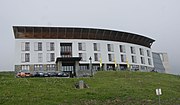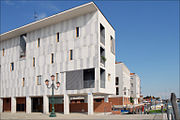International Piranesi Award
The International Piranesi Award, is an biennial award for architectural projects that were created in several nations in Central Europe and the Balkans.
Started in 1989, the Piranesi Award is given out at the Piran Days of Architecture international conference in Piran, Slovenia. It was named after Giovanni Battista Piranesi. Participating countries include Austria, Bosnia, Croatia, the Czech Republic, Greece, Herzegovina, Hungary, Italy, Serbia, Slovakia, and Slovenia.
Main award[]
The projects presented at the Piranesi exhibition, are selected and nominated at the end of October by the national selectors of the participating countries. Each selector can propose five projects. Fifty architectural realizations compete for the award.
The distinguished Piranesi Award, two Piranesi Honorable Mentions, and one Piranesi Student's Honorable Mention are selected by an international jury consisting of annual PDA conferencing lecturers and conferred by the honorary sponsor of the PDA Conference.
In 1989, Bogdan Bogdanović received the first Piranesi award for the Dudik Memorial Park in Vukovar, Croatia.[1]
Recipients[]
- 1989 Bogdan Bogdanović, Yugoslavia for Dudik Memorial Park, Vukovar, 1978–1980
- 1990 Vojteh Ravnikar, Slovenia for Resljeva apartment building, Ljubljana[2]
- 1991 , Italy for office building Bergamin, Portogruaro[3]
- 1992 , Austria for Student residence WIST, Graz, 1989[4]
- 1993 , , Austria for Silvrettahaus, Bielerhöhe Pass[5]
- 1994 with , and , Italy for Parco Botanico Friulano "Cormor", 1990–93[6]
- 1995 , Austria for "Gucklhupf", Mondsee, 1992–93[7]
- 1996 , Italy and , Portugal for Piazza N. Green
- 1997 and , Austria for the Bruno Kreisky School, Vienna[8]
- 1998 and , Slovenia for rest areas on the Kras cycling path[9]
- 1999 , Slovenia for Chamber of Commerce and Industry of Slovenia, Ljubljana
- 2000 , Slovenia for parting hall and service buildings of the , Novo Mesto
- 2001 , Italy for the plan for the , Giudecca, Venice[10]
- 2002 , , , , and , Slovenia for Primary School Ob Rinži, Kočevje[11]
- 2003 , Slovenia for Shelter, Kobariški Stol
- 2004 , Špela Kuhar, Blaž Medja, Uroš Pavasovič, Robert Potokar, Slovenia for Unified memorial posts for hidden burial ground in Slovenia
- 2005 , Saša Randić, Croatia for Primary school Fran Krsto Frankopan, island Krk
- 2006 Enota, Dean Lah, Milan Tomac, Slovenia for Hotel Sotelia in spa Olimia, Olimje
- 2007 , Croatia for Kindergarten Sunce-Retkovec, Zagreb
- 2008 , Martin Vojta, Slovakia for Family house in Cernošice, CZ
- 2009 , Greece for Aloni house in Antiparos
- 2010 , Matjaž Bolčina, Slovenia for The manor Naskov dvorec, Maribor, 2009
- 2011 , Austria for Aflenzbrücke, Lorüns, 2010
- 2012 , Austria for Islamic cemetery, Altach, 2011
- 2013 Modus, Sandy Attia, Matteo Scagnol, Italy for Ring road, Bressanone, 2012
- 2014 , Balázs Marián, Hungary for Wine terrace and spa, Eger, Almagyar
- 2015 , Croatia for Market and fish market, Vodice
- 2016 , Maša Živec, Matjaž Bolčina, Slovenia for Renovation of Plečnik's house in Ljubljana, 2015
- 2017 for Chapel Salgenreute Krumbach, Austria, 2016
- 2018 for Galerie n09 – z33, Hasselt, Belgium, 2018
- 2019 for New Gallery and Kasemattes, Neue Bastei, Wiener Neustadt, Austria, 2019
Gallery[]

Monument at the Dudik Memorial Park by Bogdan Bogdanović

Silvrettahaus, Bielerhöhe Pass

, Giudecca, Venice

Student award[]
The Piranesi conference also includes an international student exhibition with awards. Participants includes eventeen architectural faculties in Europe – Graz, Spittal, Vienna, Banja Luka, Sarajevo, Split, Zagreb, Thessaloniki, Budapest, Pescara, Trieste, Bratislava, Ljubljana, Maribor, Belgrade, Novi Sad, and London.
Each faculty nominates two student projects for consideration.
References[]
- ^ Sørensen, M.L.S.; Viejo-Rose, D.; Filippucci, P. (2019). Memorials in the Aftermath of Armed Conflict: From History to Heritage. Palgrave Studies in Cultural Heritage and Conflict. Springer International Publishing. p. 194. ISBN 978-3-030-18091-1. Retrieved 3 June 2021.
- ^ Gmeiner, A.; Schaden, H.; Stadtplanung Wien (1992). WIENER ARCHITEKTURSEMINAR /VIENNA ARCHITECTURE:. Edition Axel Menges. Ernst & Sohn. p. 112. ISBN 978-3-433-02396-9. Retrieved 3 June 2021.
- ^ "Storia". Bergamin (in Italian). Retrieved 3 June 2021.
- ^ Jones, P.B. (1998). Dialogues in Time: New Graz Architecture. Haus der Architektur. p. 358. ISBN 978-3-901174-36-0. Retrieved 3 June 2021.
- ^ Leeb, F.; Lenz, G. (2017). Architektur von Dietrich | Untertrifaller / Architecture by Dietrich | Untertrifaller / Architecture de Dietrich | Untertrifaller (in German). Birkhäuser. p. 384. ISBN 978-3-0356-0900-4. Retrieved 3 June 2021.
- ^ Pellegrini, P.C.; Acocella, A.; Casamonti, M. (1999). Lo spazio pubblico in Italia 1990–1999. Arredare la città (in Italian). Alinea. p. 122. ISBN 978-88-8125-341-8. Retrieved 3 June 2021.
Nel 1994 è vincitore del "Premio Internazionale di Architettura Piranesi" con il progetto del "Parco del Cormor" ad Udine.
- ^ Wörndl, Hans Peter (24 October 2014). "Gucklhupf". Washington University Open Scholarship. Retrieved 3 June 2021.
- ^ Mies Van Der Rohe Pavilion Award for European Architecture. V+K Pub. 1999. p. 58. Retrieved 3 June 2021.
- ^ Ivanic, M.; Kuhar, Š. (2008). Contemporary School Architecture in Slovenia 1991–2007. Springer Vienna. ISBN 978-3-211-76844-0. Retrieved 3 June 2021.
- ^ Falsitta, M.; Campigotto, L.; Giardini di Castello (Venice, Italy) (2002). Architecture of primary space:. F. Motta. p. 236. ISBN 978-88-7179-362-7. Retrieved 3 June 2021.
- ^ Meissner, G.; K.G. Saur Verlag (1992). Allgemeines Künstlerlexikon: A-Alanson. Allgemeines Künstlerlexikon: die bildenden Künstler aller Zeiten und Völker (in German). Saur. p. 90. ISBN 978-3-598-22740-0. Retrieved 3 June 2021.
External links[]
- Architecture awards
- Awards established in 1989
- European awards



